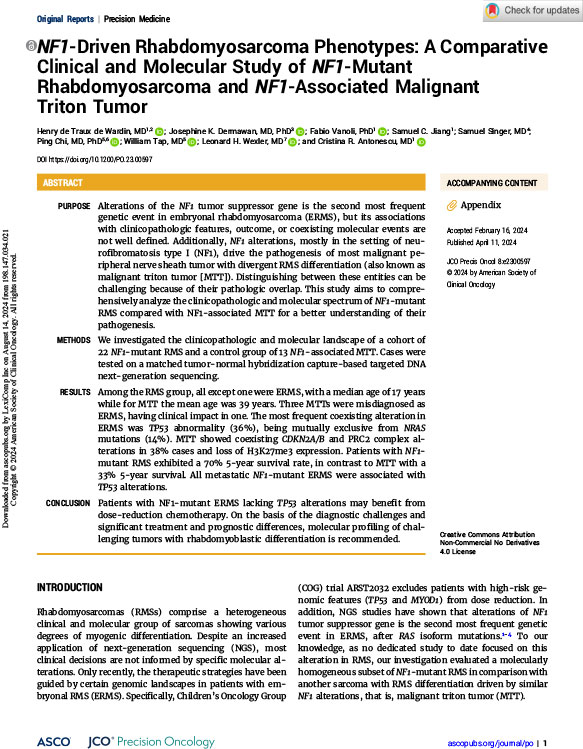NF1-Driven Rhabdomyosarcoma Phenotypes: A Comparative Clinical and Molecular Study of NF1-Mutant Rhabdomyosarcoma and NF1-Associated Malignant Triton Tumor
April 2024
Abstract
Purpose
Alterations of the NF1 tumor suppressor gene is the second most frequent genetic event in embryonal rhabdomyosarcoma (ERMS), but its associations with clinicopathologic features, outcome, or coexisting molecular events are not well defined. Additionally, NF1 alterations, mostly in the setting of neurofibromatosis type I (NF1), drive the pathogenesis of most malignant peripheral nerve sheath tumor with divergent RMS differentiation (also known as malignant triton tumor [MTT]). Distinguishing between these entities can be challenging because of their pathologic overlap. This study aims to comprehensively analyze the clinicopathologic and molecular spectrum of NF1-mutant RMS compared with NF1-associated MTT for a better understanding of their pathogenesis.
Methods
We investigated the clinicopathologic and molecular landscape of a cohort of 22 NF1-mutant RMS and a control group of 13 NF1-associated MTT. Cases were tested on a matched tumor-normal hybridization capture-based targeted DNA next-generation sequencing.
Results
Among the RMS group, all except one were ERMS, with a median age of 17 years while for MTT the mean age was 39 years. Three MTTs were misdiagnosed as ERMS, having clinical impact in one. The most frequent coexisting alteration in ERMS was TP53 abnormality (36%), being mutually exclusive from NRAS mutations (14%). MTT showed coexisting CDKN2A/B and PRC2 complex alterations in 38% cases and loss of H3K27me3 expression. Patients with NF1-mutant RMS exhibited a 70% 5-year survival rate, in contrast to MTT with a 33% 5-year survival. All metastatic NF1-mutant ERMS were associated with TP53 alterations.
Conclusion
Patients with NF1-mutant ERMS lacking TP53 alterations may benefit from dose-reduction chemotherapy. On the basis of the diagnostic challenges and significant treatment and prognostic differences, molecular profiling of challenging tumors with rhabdomyoblastic differentiation is recommended.

